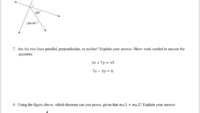rachelmaddie
Full Member
- Joined
- Aug 30, 2019
- Messages
- 851
Can you please check my work for this question?
Get both equations into the form y = mx + b. Then look at the slope
If the slopes are equal, the lines are parallel
If the slope of one is the negative reciprocal of the other(products are equal to -1), the lines are perpendicular
3x + 7y = 15
7x - 3y = 6
In the slope- intercept form m = slope, b = y intercept
y = 15 - 3x/7
y = 15/7 - 3/7x
The slope of the first line is -3/7
7x - 3y = 6
y = 7x - 6/3
y = 7/3x - 2
The slope of the second line is 7/3
Second step, Compare the slopes
Since -3/7 is not equal to 7/3, line 1 and line 2 are not parallel
To check for perpendicular lines m1 * m2 = (-3/7) * (7/3) = -1
Lines l1 and l2 are perpendicular because the product of their slopes is -1.

Get both equations into the form y = mx + b. Then look at the slope
If the slopes are equal, the lines are parallel
If the slope of one is the negative reciprocal of the other(products are equal to -1), the lines are perpendicular
3x + 7y = 15
7x - 3y = 6
In the slope- intercept form m = slope, b = y intercept
y = 15 - 3x/7
y = 15/7 - 3/7x
The slope of the first line is -3/7
7x - 3y = 6
y = 7x - 6/3
y = 7/3x - 2
The slope of the second line is 7/3
Second step, Compare the slopes
Since -3/7 is not equal to 7/3, line 1 and line 2 are not parallel
To check for perpendicular lines m1 * m2 = (-3/7) * (7/3) = -1
Lines l1 and l2 are perpendicular because the product of their slopes is -1.
